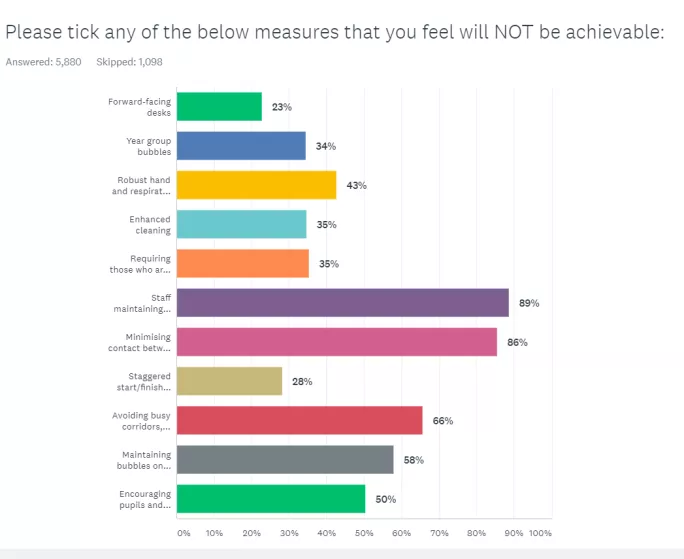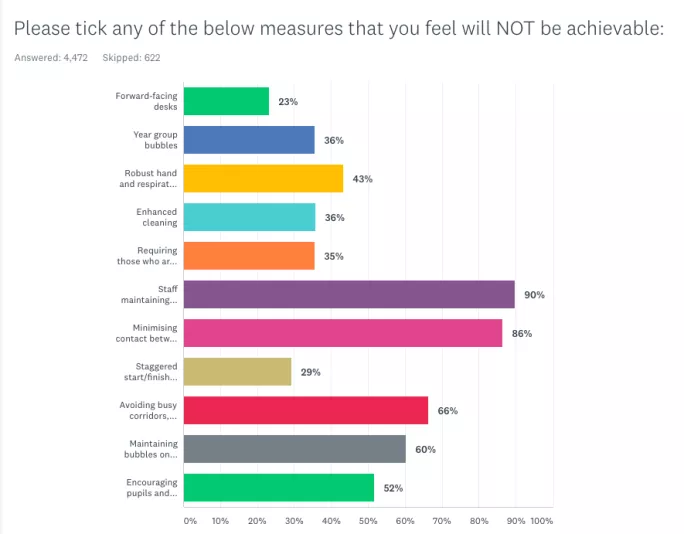- Home
- Distancing in schools unachievable, say 90% of teachers
Distancing in schools unachievable, say 90% of teachers

Nearly nine in 10 school staff believe keeping their distance from both pupils and one another will not be achievable when schools reopen tomorrow, Tes can reveal.
And two-thirds (66 per cent) fear guidance to avoiding busy corridors, entrances and exits is unrealistic, according to a Tes survey of nearly 6,000 school staff in England.
Asked to select which measures from Department for Education guidance they feel “will not be achievable” when schools open to all pupils next term, staff - including heads, teachers and teaching assistants - were most likely to select “staff maintaining distance from pupils and other staff” (89 per cent).
Revealed: Huge staff doubts about school Covid safety
Exclusive: 28% of teachers may flout test and trace
U-turn: Masks ‘should be’ worn in high-risk secondaries
“Minimising contact between pupils” will not be achievable, according to 86 per cent of staff, and two-thirds don’t view “avoiding busy corridors, entrances and exits” as possible.
Ministers have stressed the importance of these measures in allowing schools to open safely. On Thursday, health secretary Matt Hancock said schools would need to be certain that social distancing was in place between staff and pupils to ensure coronavirus was not spread between schools by supply teachers.
‘Schools must do everything possible to minimise contacts’
The government guidance states that “schools must do everything possible to minimise contacts and mixing while delivering a broad and balanced curriculum”.
In response to the Tes survey held just before the end of last term, one teaching assistant said: “In our school, the corridors are less than two metres wide, so it will be difficult to maintain distance from other staff.
“Movement around the building has been limited, so most pupils are staying in one area of the school which will make things slightly easier. However, break and lunchtimes will be difficult to manage with multiple year groups on break and lunch at the same time, due to the size of our site.”
A deputy/assistant head added: “I have seen staff too close to pupils when helping them learn and some children are too close physically. A consistent safe distance is not achievable.”
‘Walls don’t expand easily’
And a school librarian said simply: “Walls don’t expand easily”.

More than half of staff (58 per cent) were worried about “maintaining bubbles on school transport”, while 50 per cent said “encouraging pupils and staff to avoid public transport” would not be achievable.
A teaching assistant at a special school said: “We have had long conversations about transport. All our pupils come in wheelchair minibuses or in taxis. However hard we try to maintain bubbles in school, those do not apply to transport.
“Devon says to maintain social distance on transport would cost an additional £43,000 per day.”
And a teacher added: “Asking children and staff to not use public transport would be ridiculous - if they usually use it, it’s because they HAVE to in order to get to school.
“They can’t just magically find an alternative way to get there. This would just affect the disadvantaged children more and lead to them possibly missing more time off school if parents don’t feel willing to use their usual mode of public transport.”
‘Robust hand washing will be a huge issue’
Maintaining “robust hand and respiratory hygiene” was also a concern for more than two in five staff (43 per cent), while just over a third (35 per cent) feared it would not be possible to carry out “enhanced cleaning”.
One teacher said: “We have four classes using one set of toilets. Robust hand washing will be a huge issue.”
Another teacher added: “Teachers have been providing cleaning products independently for years. How long will schools afford to pay for enhanced cleaning? It has already fallen to teachers and maintaining it was exhausting in early years.”
And a teaching assistant said: “Handwashing at regular intervals requires lots of time - it took a while with just the keyworker children, I can only imagine the delays with a full school.”
‘Whole year bubbles are a ridiculous concession’
Just over a third of staff said they had concerns about “requiring those who are ill to stay at home” (35 per cent), and “year group bubbles” (34 per cent).
“Whole year bubbles are a ridiculous concession. If asymptotic virus carriers come to school they could infect whole classes before anyone notices,” one special educational needs (SEN) teacher said.
Meanwhile, more than a quarter of staff (28 per cent) said they could not achieve “staggered start/finish times”, while more than a fifth (23 per cent) took issue with “forward-facing desks”.
One teaching assistant said: “When staff have to move between classes having multiple start time will become tricky and staff will inevitably be late to lessons. This will lead to some children taking advantage and causing disruption.
“Older children seem to be unable to stay at a distance from one another. Children will be late to school and it will be economically unsustainable for buses to only take one year at a time, as our more rural children arrive from every direction.”
The percentages were broadly similar when the 4,472 responses from just teachers in England were looked at.

Geoff Barton, general secretary of the Association of School and College Leaders (ASCL), said: “One of the biggest challenges of the return to school is going to be around how people naturally interact with one another and the difficulty in remembering to maintain distance and minimise contact.
‘This won’t work perfectly’
“This won’t work perfectly, there will be lapses from time to time, but it will improve over time as everybody becomes used to interacting in a way that reduces the risk of transmission.”
A DfE spokesperson said: “Getting all children back into their classrooms full-time in September is a national priority because it is the best place for their education, development and wellbeing. This will be particularly important for disadvantaged children and those with special educational needs.
“We have always been clear in our guidance about the protective measures that schools should implement to reduce risks for staff and pupils as far as possible.
“Parents are becoming increasingly confident in their children returning to school, which is testament to the work of school staff across the country who are putting in place a range of protective measures to prepare to welcome back all pupils at the start of term.”
Keep reading for just £1 per month
You've reached your limit of free articles this month. Subscribe for £1 per month for three months and get:
- Unlimited access to all Tes magazine content
- Exclusive subscriber-only stories
- Award-winning email newsletters



